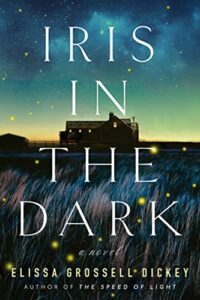Chances are, your favorite suspense novels are stories filled with unexpected twists and turns; pulse-pounding, page-turning action; and gritty, dark discoveries.
But even the darkest thriller is balanced with a sliver of light. And what better to bring in that light than love—a compelling love interest who stands by the main character amidst all the chaos.
Many readers have commented on the creep factor of my new novel, Iris in the Dark, when the main character hears a chilling voice in the night while staying at a remote hunting lodge on the South Dakota prairie. But just as many readers have raved about the love interest, the swoony lodge caretaker, Sawyer. To me, each aspect of the story is as important as the other—providing the right balance of light and dark.
So how do you create a compelling love interest? To start, let’s take a look at some traits Sawyer shares with other well-written characters in some of my favorite suspenseful reads:
Support: In Iris in the Dark, my main character, Iris, goes through some scary times—but as she dives into the mystery of the voice, Sawyer is there for support, despite being concerned for her safety. Likewise, in Amy Suiter Clarke’s incredible debut, Girl, 11, main character Elle puts herself at risk investigating a killer. Clarke wrote a strong love interest in Elle’s husband, Martin, who was worried about her safety but also very supportive.
Stability: For Iris, Sawyer’s reassuring presence provided stability when the world around her was anything but. Similarly, in Aggie Blum Thompson’s riveting I Don’t Forgive You, main character Allie’s life is thrown into chaos when she’s framed for murder, digging up her past—but her husband, Mark, provides a stable tether to reality in her present life.
The Right Strengths: In my book, Sawyer’s strengths complement Iris’s weaknesses—from his cooking abilities to his sense of calm in the face of danger. In the phenomenal Mexican Gothic by Silvia Moreno-Garcia, Francis’s strengths—his connection to his house and family—provided crucial help to Noemi when she needed it most.
Tragic Back Story: Sawyer, like Iris, experienced his own past tragedy, and this is something they share that brings them closer together. Likewise, in Paulette Kennedy’s outstanding debut, Parting the Veil, Eliza is drawn to Malcolm despite—or, perhaps, because of—his mysterious, dark past in the potentially haunted home they now share.
A Shred of Doubt: Finally, the trait that is arguably the most compelling is that tiny spark of doubt—the inkling of uncertainty that makes readers ask if this person is truly who they claim to be. In each of the books I’ve mentioned, as well as my own, there are moments that make readers question: Can they really be trusted, or could they be secretly working against the main character?
To me, that uncertainty is the best part of a thriller for readers. They think they caught all the clues, but don’t quite know for sure—so they compulsively turn pages until they reach the answer.
As authors, we want our work to invoke that emotion in our readers, driving them to solve the riddle of our story—and a compelling love interest is a crucial piece of that puzzle.
Putting the Puzzle Together
So how do you make sure you fit those puzzle pieces together just right? Here are some tips you can use during the writing and revising process that can help you on the road to crafting your story’s perfect love interest:
Ask the right questions: First, ask yourself: What does my main character need most on her journey—and how can my love interest provide that? As I noted above, in my novel, Iris needs stability and support as she searches for the truth. However, that might not be true of your main character. Perhaps your MC needs a love interest who will push them out of their comfort zone in order to uncover the secrets they’re seeking to reveal.
Make a list: Another tip is making a list of your main characters’ strengths and weaknesses. Then, create a similar list for your love interest and see how the characters complement each other. I’m not saying you should entirely construct a love interest to match the main character—you want them to feel authentic, so their characteristics won’t perfectly align with the MC. But, if you can identify some strong traits that match well, then you know you have a good fit.
Create a character arc: Speaking of authenticity, another idea is to create a character arc for your love interest to make sure they feel like a real person. That could mean filling out a beat sheet from your love interest’s point of view, or it could mean making a list of your love interest’s wants, needs, and goals outside of the main character.
Write their back story. It’s time for some free writing, starting with a few past scenes that are key to your love interest’s back story. Even if you don’t end up using it in your manuscript, these scenes from the past will be crucial to tapping into your love interests’ current emotions and motivations. (And you never know what small piece of that writing might end up fitting into your final draft.)
Plant some clues: Circling back to the uncertainty—if you want to plant a seed of doubt about your love interest, use one of your revision passes to sprinkle in some subtle clues, whether it’s hinting at time unaccounted for off the page, or adding an ambiguously ominous statement. In the end, your love interest might be the real deal—after all, you’ve spent all this time crafting them to perfection—but your readers won’t know that for sure.
And if you can keep them guessing, invested, turning pages—and swooning over your love interest even as they doubt them—then you’ve crafted not only the perfect love interest, but also the perfect reader experience.
***


















